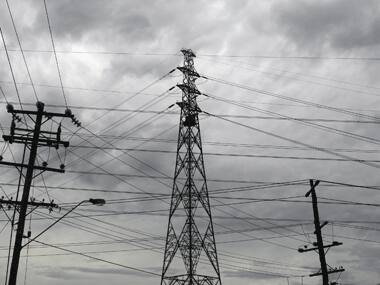Once again, the financial problems of state electricity boards are threatening to significantly disrupt consumer supplies and forcing hapless users to endure long hours of load-shedding.
Making the news this time is the Maharashtra State Electricity Distribution Company (MSEDCL), which has warned that it will introduce power cuts of up to 11 hours across various regions in the state because of a lack of funds to buy power from generating companies and power generation disruptions among its suppliers.
[caption id=“attachment_101217” align=“alignleft” width=“380” caption=“Maharashtra will have to rethink its power strategy”]
 [/caption]
[/caption]
MSEDCL is a state-run company that distributes electricity to all regions of the state, except Mumbai city and most of its suburban region; in those parts, BEST, Reliance Energy and Tata Power are the only distributors.
While the power supply issues for MSEDCL are temporary, the funds crunch is not. The distribution company faces a revenue gap of a little more than Rs 5,155 crore and had sought to recover Rs 4,847 crore by levying a uniform surcharge of 61 paise per unit from 1 September, until the tariffs for 2011-2012 were finalised.
But the Maharashtra Electricity Regulatory Commission (MERC) refused MSEDCL’s petition, saying that since the proposal to hike tariffs was due for a public hearing, an interim price hike could not be allowed. MSEDCL responded by announcing that since it had no money to buy power at more than Rs 4 per unit (the market rate for short-term power is about Rs 7-10), it would start cutting power to consumers.
Impact Shorts
More ShortsUnfortunately, in this tussle between MSEDCL and the state electricity regulator, it’s the consumers who are being abandoned in the dark. It’s a classic example of how government interference and influence negatively affecting the financial health of the companies it manages.
Earlier this year, power ministry officials admitted that the accumulated losses of state electricity boards (SEBs) totaled more than Rs 2.5 trillion. Another recent estimate suggested that in 2010-2011 alone, electricity distribution losses might have totalled a jaw-dropping Rs 70,000 crore.
The big problem for electricity distribution companies is the mismatch between power tariffs and the cost of generating electricity. As long as this issue is not resolved, the financial position of SEBs will always be shaky, no matter how many times they are bailed out by the state or central government.
What’s the solution then?
Without doubt, power tariffs need to be hiked. Consumers need to start paying proper market prices for the power they consume. Yet, raising power tariffs however is considered politically unpalatable and state governments have often pressured distribution companies to refrain from doing so. A CSFB report earlier this year noted that power tariff had increased by about 5.2 percent every year between March 2003 and March 2009. However, power purchase costs during that time climbed by 7.3 percent every year. Purchase costs are expected to keep rising given the increasing prices of coal and gas. In Maharashtra, MSEDCL is trying to raise prices, but is running into regulator resistance.
In addition, power hikes face stiff resistance from consumers, especially residential. However, some studies suggest that consumers actually might be ok with paying higher prices for continuous power supply, instead of being content with cheaper prices for irregular supply.
There is also a case to end subsidies to residential power users at the cost of industrial users. Currently, bulk industrial users pay more for their power consumption compared with lower-use, lower-revenue generating residential users. Agricultural users also get subsidised power.
That’s contrary to how power markets operate around the world, where bulk users are typically given discounts for heavy use, while the lower-use consumers pay more. Just like subsidies on petrol were lifted last year, it can be argued that susbsidies on domestic power use can be lifted as well.
There’s also an urgent need to end the government’s role in determining power tariffs. But as long as electricity distribution companies are state-run, that will never be the case. The electricity regulator also needs to truly independent of government influence.
That brings us to the issue of privatisation, which is one possible solution to the escalating financial problems of state-run electricity distribution companies.
Several state-controlled electricity companies are being “unbundled” into separate generation, transmission and distribution companies. But even after unbundling, a lot of the functions continue to be controlled by governments, which prevents the entities from charging proper tariffs.
That’s why the the results of privatisation have, so far, been mixed: in Orissa, those efforts have failed, while in Delhi, where the distribution company has been allowed to hike prices, seems to have become a good model to replicate.
Finally, transmission and distribution (T&D) losses need to be drastically cut. Currently T&D losses are around 25 percent, one of the highest in the world, compared with the 4-6 percent loss seen in developed markets. Given that installed power capacity in the country is about 180,000 megawatts (MW), T&D losses amount to 45,000 MW. Given that it costs Rs 5 crore to increase capacity by 1 MW , the country needs to spend an additional Rs 2,25,000 crore to just compensate for that loss. Power theft is also rampant. There are efforts to upgrade distribution systems with smart-grid technology, but it needs to be done at a faster pace.
Unfortunately, given the shaky financial status of SEBs, investments are unlikely to be forthcoming. Indeed, banks are now withholding working capital loans to SEBs, according to analyst reports.
Will all this force state governments to finally release their grip on SEBs? Don’t hold your breath.
)